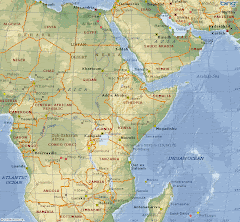Front of our place- We have the end room in a row of rooms. It's nice and new, and freshly painted. The door was tricky at first though- you have to reach in the hole to unlock/lock the bars from the inside, and in the beginning that process took several minutes and left me with bruises all over the upper part of my arm. Just a wee bit embarrassing to struggle like that in front of the new neighbors!

My 'bedroom.' I sprang for the 25,000 Ush/$13.00 mattress which has been not not only comfortable, but also an important buffer against the creepy crawlies on the floor. The net also helps- I'm a big fan! We used lesu for curtains (cloth that ladies usually wrap around to protect their clothes while cleaning). Do me a favor and try not to notice how dirty my feet are in this pic- it's almost impossible to keep them clean during rainy season!

My roomie Amie (former international program coordinator for FSD, now volunteering with Right to Play), stands near our 'kitchen area' and in front of the doorway to her room. She was awesome to live with, I'm so glad that it worked out that our schedules matched up!

Brock and Hagar in the 'living room.' Since Brock and Hagar moved into a place nearby, we often came over to each other's places to cook dinner and enjoy music together. Notice the floor mats woven by Jenipher, and the sheet making a closet to hide anything unsightly (such as undergarments drying on the line!)

Our 'facilities.' I've spared you the internal view of the pit latrine and bath room. They are quite adequate, though we have to share them with a swarm of flies by day and giant cockroaches by night...

View of the compound - Nice and private. You can see the water tap toward the front- that's where we would fill our jerry cans for bathing, cooking, and washing water. Sometimes we also harvested rainwater using our various pots and basins.















